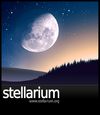Software:Stellarium
 | |
 | |
| Original author(s) | Fabien Chéreau |
|---|---|
| Developer(s) | Alexander Wolf Georg Zotti Marcos Cardinot Guillaume Chéreau Bogdan Marinov Timothy Reaves Florian Schaukowitsch |
| Initial release | 2001 |
| Stable release | 23.4[1]
/ December 23, 2023 |
| Written in | C++ (Qt) |
| Operating system | Linux, Windows, macOS |
| Platform | PC, Mobile |
| Size | 345 MB (Linux tarball) 261 MB (Windows 32-bit installer) 265 MB (Windows 64-bit installer) 243 MB (macOS package) |
| Type | Educational software |
| License | GNU GPLv2[2] |
Stellarium is a free and open-source planetarium, licensed under the terms of the GNU General Public License version 2, available for Linux, Windows, and macOS. A port of Stellarium called Stellarium Mobile is available for Android, iOS, and Symbian as a paid version, being developed by Noctua Software. These have a limited functionality, lacking some features of the desktop version. All versions use OpenGL to render a realistic projection of the night sky in real time.[citation needed]
Stellarium was featured on SourceForge in May 2006 as Project of the Month.[3]
History
In 2006, Stellarium 0.7.1 won a gold award in the Education category of the Les Trophées du Libre free software competition.[4]
A modified version of Stellarium has been used by the MeerKAT project as a virtual sky display showing where the antennae of the radiotelescope are pointed.[5]
In December 2011, Stellarium was added as one of the "featured applications" in the Ubuntu Software Center.[6]
Planetarium dome projection
The fisheye and spherical mirror distortion features allow Stellarium to be projected onto domes. Spherical mirror distortion is used in projection systems that use a digital video projector and a first surface convex spherical mirror to project images onto a dome. Such systems are generally cheaper than traditional planetarium projectors and fish-eye lens projectors and for that reason are used in budget and home planetarium setups where projection quality is less important.[citation needed]
Various companies which build and sell digital planetarium systems use Stellarium, such as e-Planetarium.[7][non-primary source needed]
Digitalis Education Solutions, which helped develop Stellarium, created a fork called Nightshade which was specifically tailored to planetarium use.[8][9][non-primary source needed]
VirGO
VirGO is a Stellarium plugin, a visual browser for the European Southern Observatory (ESO) Science Archive Facility which allows astronomers to browse professional astronomical data. It is no longer supported or maintained; the last version was 1.4.5, dated January 15, 2010.[10][non-primary source needed]
Stellarium Mobile
Stellarium Mobile is a fork of Stellarium, developed by some of the Stellarium team members. It currently targets mobile devices running Symbian, Maemo, Android, and iOS. Some of the mobile optimisations have been integrated into the mainline Stellarium product.[11][non-primary source needed][|permanent dead link|dead link}}]
Screenshots
-
Constellation art in version 0.6.2
-
Constellation art in version 0.10.1
-
Mars and its moons in Stellarium 0.14
-
Equatorial and Azimuthal Grids in Stellarium 0.14
-
Screenshot of Night Mode in Stellarium 0.14
See also
References
- ↑ Wolf, Alexander (December 23, 2023). "v23.4". https://github.com/Stellarium/stellarium/releases/tag/v23.4.
- ↑ "~stellarium/stellarium/trunk : contents of COPYING at revision 9976". https://bazaar.launchpad.net/~stellarium/stellarium/trunk/view/head:/COPYING.
- ↑ "Project of the Month – May 2006 – Stellarium". May 2006. http://sourceforge.net/potm/potm-2006-05.php.
- ↑ "The third Free Software Awards placed under the sign of the international" (in fr). Les Trophées du Libre 2006 website. http://tropheesdulibre2006.org/.
- ↑ "Virtual sky display in MeerKAT control room". Ska.ac.za. http://www.ska.ac.za/newsletter/issues/12/12.php.
- ↑ "Software Centre app picks for December". Developer.ubuntu.com. December 14, 2011. http://developer.ubuntu.com/2011/12/software-centre-app-picks-for-december/.
- ↑ "Stellarium Planetarium Software". E-Planetarium website. http://www.e-planetarium.com/stellarium.htm.
- ↑ "Nightshade Astronomy Simulation Software". Digitalis Education Solutions official website. http://www.digitaliseducation.com/products-nightshade.html.
- ↑ "Nightshade Astronomy Simulator". Nightshade official website. http://www.nightshadesoftware.org.
- ↑ "VirGO, The Visual Archive Browser". ESO Science Archive Facility. http://archive.eso.org/cms/tools-documentation/visual-archive-browser.html.
- ↑ "Stellarium Mobile". Noctua Software. http://www.noctua-software.com/stellarium-mobile.
External links
| Wikimedia Commons has media related to Stellarium. |





